 Microsoft’s Copilot AI awaits, demon-like, for my summons so that it might replace my words with its own. The temptation is great, but I resist and persist in relying on my own skills. But some warn that others will lack my resolve, and the academy will be destroyed by a deluge of cheating.
Microsoft’s Copilot AI awaits, demon-like, for my summons so that it might replace my words with its own. The temptation is great, but I resist and persist in relying on my own skills. But some warn that others will lack my resolve, and the academy will be destroyed by a deluge of cheating.
Those profiting from AI, including those selling software promising to detect AI cheating, speak dire warnings of the dangers of AI and how it will surpass humans in skills such as writing and taking tests. Because of this, the regulations written by the creators of AI must become law and academic institutions must subscribe to AI detection tools. And, of course, embrace AI themselves. While AI does present a promise and a threat, there is the question of whether it will destroy the academy as we know it. The first issue I will address is whether AI cheating will “destroy” the academy.
Students, I suspect, have been cheating since the first test and plagiarism has presumably existed since the invention of language. Before the internet, plagiarism and detecting plagiarism involved finding physical copies of works. As computers and the internet were developed, digital plagiarism and detection evolved. For example, many faculty use Turnitin which can detect plagiarism. It seemed that students might have been losing the plagiarism arms race, but it was worried that easy access to AI would turn the battle in favor of the cheating students. After all, AI makes cheating easy, affordable and harder to detect. For example, large language models allow “plagiarism on demand” by generating new text with each prompt. As I write this, Microsoft has made Copilot part of its office subscription and as many colleges provide the office programs to their students, they are handing students tools for cheating. But has AI caused the predicted flood of cheating?
Determining how many students are cheating is like determining how many people are committing crime: you only know how many people have been caught or admitted to it. You do not know how many people are doing it. Because of this, inferences about how many students are cheating need to be made with caution so as to avoid the fallacy of overconfident inference from unknown statistics.
One source of data is Turnitin’s AI detection software. Over the course of a year, the service checked 200 million assignments and flagged AI use in 1 in 10 assignments while 3 in 100 were flagged as mostly AI. These results have remained stable, suggesting that AI cheating is neither a tsunami nor increasing. But this assumes that the AI detection software is accurate. Turnitin claims it has a false positive rate of 1%. But we need to worry about AI detection software generating false positives and false negatives.
For false positives, one concern is that “GPT detectors are biased against non-native English writers.” For false negatives, the worry is that AI detectors can be fooled. As the algorithms used in proprietary detection software are kept secret, we do not know what biases and defects they might have. For educators, the “nightmare” scenario is AI generated work that cannot be detected by software and evades traditional means of proving that cheating has occurred.
While I do worry about the use of AI in cheating, I do not think that AI will significantly increase cheating and that if the academy has survived older methods of cheating, it will survive this new tool. This is because I think that cheating has and will remain consistent. In terms of my anecdotal evidence, I have been a philosophy professor since 1993 and have a consistent plagiarism rate of about 10%. When AI cheating became available, I did not see a spike in cheating. Instead, I saw AI being used by some students in place of traditional methods of cheating. But I must note that this is my experience and that it is possible that AI generated papers are slipping past Turnitin. Fortunately, I do not need to rely on my experience and can avail myself of the work of experts on cheating.
Stanford scholars Victor Lee and Denise Pope have been studying cheating, and past surveys over 15 years showed that 60-70% of students admitted to cheating. In 2023 the percentage stayed about the same or decreased slightly, even when students were asked about using AI. While cheaters might lie about cheating, Pope and Lee use methods to address this challenge. While cheating remains a problem, AI has not increased it and hence reports of the death of the academy are premature. It will, more likely, die by another hand.
This lack of increase makes intuitive sense as cheating has always been easy and the decision to cheat is more a matter of moral and practical judgment rather than being driven by technology. While technology provides new means of cheating, a student must be willing to cheat, and that percentage seems stable. But it is worth considering that there might have been a wave of AI cheating but for efforts to counter it, to not consider this would be to fall for the prediction fallacy.
It is also worth considering that AI has not lived up to the hype because it is not a great tool for cheating. As Arvind Narayanan and Sayash Kapoor have argued, AI is most useful at doing useless things. To be fair, assignments in higher education can be useless. But if AI is being used to complete useless assignments, this is a problem with the assignments (and the professors) and not AI.
But large language models are a new technology and their long-term impact in cheating needs to be determined. Things could change in ways that do result in the predicted flood and the doom of the academy as we know it. In closing, while AI cheating will probably not destroy the academy, we should not become complacent. Universities should develop AI policies based on reliable evidence. A good starting point would be collecting data from faculty about the likely extent of AI cheating.

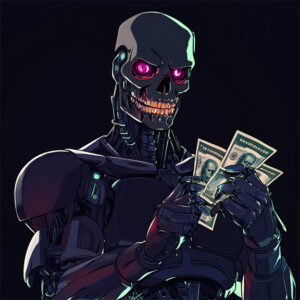 Thanks to The Terminator, people think of a Skynet scenario as the likely AI apocalypse. The easy and obvious way to avoid a Skynet scenario is don’t arm the robots. Unfortunately, Anduril and OpenAI seem intent on “doing a Skynet” as
Thanks to The Terminator, people think of a Skynet scenario as the likely AI apocalypse. The easy and obvious way to avoid a Skynet scenario is don’t arm the robots. Unfortunately, Anduril and OpenAI seem intent on “doing a Skynet” as 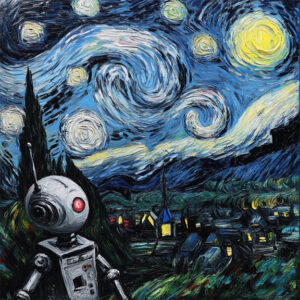 AI generated works have already disrupted the realm of art. As noted in the previous essay, this is a big problem for content art (art whose value is derived from what it is or how it can be used). However, I will show that named art might enjoy some safety from AI incursions.
AI generated works have already disrupted the realm of art. As noted in the previous essay, this is a big problem for content art (art whose value is derived from what it is or how it can be used). However, I will show that named art might enjoy some safety from AI incursions.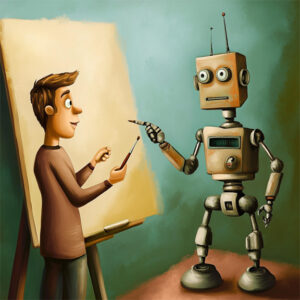 This essay changes the focus from defining art to the economics of art. This discussion requires making a broad and rough distinction between two classes of art and creators. The first class of art is called “named art.” This is art whose value derives predominantly from the name and fame of its creator. Works by Picasso, van Gogh, Rembrandt and the like fall into this category. Artists who are enjoying a fleeting fame also fall into this category, at least so long as their name is what matters. This is not to deny that such art can have great and wonderful qualities of its own; but the defining feature is the creator rather than the content.
This essay changes the focus from defining art to the economics of art. This discussion requires making a broad and rough distinction between two classes of art and creators. The first class of art is called “named art.” This is art whose value derives predominantly from the name and fame of its creator. Works by Picasso, van Gogh, Rembrandt and the like fall into this category. Artists who are enjoying a fleeting fame also fall into this category, at least so long as their name is what matters. This is not to deny that such art can have great and wonderful qualities of its own; but the defining feature is the creator rather than the content.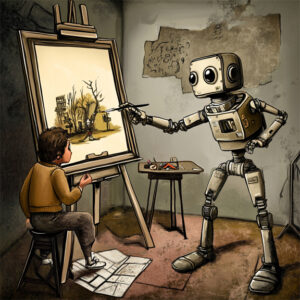 While it is reasonable to consider the qualities of the creator when determining whether a work is art, it also makes sense to consider only the qualities of the work. On this approach, what makes a work art are the relevant qualities of that work, whatever these qualities might me. It also makes sense to consider that the effect these qualities on the audience could play a role in determining whether a work is art. For example,
While it is reasonable to consider the qualities of the creator when determining whether a work is art, it also makes sense to consider only the qualities of the work. On this approach, what makes a work art are the relevant qualities of that work, whatever these qualities might me. It also makes sense to consider that the effect these qualities on the audience could play a role in determining whether a work is art. For example, 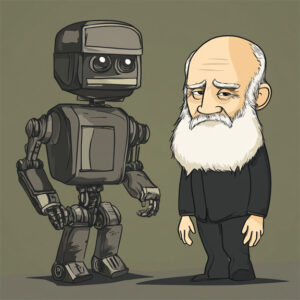 As a philosopher, my discussions of art and AI tend to be on meta-aesthetic topics, such as trying to define “art” or arguing about whether an AI can create true art. But there are pragmatic concerns about AI taking jobs from artists and changing the field of art.
As a philosopher, my discussions of art and AI tend to be on meta-aesthetic topics, such as trying to define “art” or arguing about whether an AI can create true art. But there are pragmatic concerns about AI taking jobs from artists and changing the field of art. 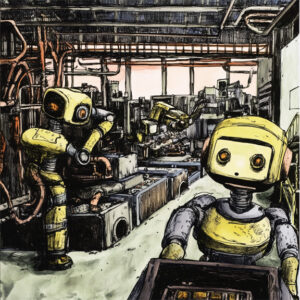 The term “robot” and the idea of a robot rebellion were introduced by Karel Capek in Rossumovi Univerzální Roboti. “Robot” is derived from the Czech term for “forced labor” which was itself based on a term for slavery. Robots and slavery are thus linked in science-fiction. This leads to a philosophical question: can a machine be a slave? Sorting this matter out requires an adequate definition of slavery followed by determining whether the definition can fit a machine.
The term “robot” and the idea of a robot rebellion were introduced by Karel Capek in Rossumovi Univerzální Roboti. “Robot” is derived from the Czech term for “forced labor” which was itself based on a term for slavery. Robots and slavery are thus linked in science-fiction. This leads to a philosophical question: can a machine be a slave? Sorting this matter out requires an adequate definition of slavery followed by determining whether the definition can fit a machine.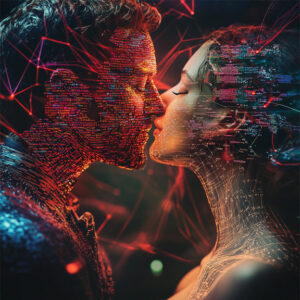 This is the last of the virtual cheating series and the focus is on virtual people. The virtual aspect is easy enough to define; these are entities that exist entirely within the realm of computer memory and do not exist as physical beings in that they lack bodies of the traditional sort. They are, of course, physical beings in the broad sense, existing as data within physical memory systems.
This is the last of the virtual cheating series and the focus is on virtual people. The virtual aspect is easy enough to define; these are entities that exist entirely within the realm of computer memory and do not exist as physical beings in that they lack bodies of the traditional sort. They are, of course, physical beings in the broad sense, existing as data within physical memory systems. While science fiction has speculated about robot-human sex and romance, current technology offers little more than sex dolls. In terms of the physical aspects of sexual activity, the development of more “active” sexbots is an engineering problem; getting the machinery to perform properly and in ways that are safe for the user (or unsafe, if that is what one wants). Regarding cheating, while a suitably advanced sexbot could actively engage in sexual activity with a human, the sexbot would not be a person and hence the standard definition of cheating (as discussed in the previous essays) would not be met. This is because sexual activity with such a sexbot would be analogous to using any other sex toy (such as a simple “blow up doll” or vibrator). Since a person cannot cheat with an object, such activity would not be cheating. Some people might take issue with their partner sexing it up with a sexbot and forbid such activity. While a person who broke such an agreement about robot sex would be acting wrongly, they would not be cheating. Unless, of course, the sexbot was enough like a person for cheating to occur.
While science fiction has speculated about robot-human sex and romance, current technology offers little more than sex dolls. In terms of the physical aspects of sexual activity, the development of more “active” sexbots is an engineering problem; getting the machinery to perform properly and in ways that are safe for the user (or unsafe, if that is what one wants). Regarding cheating, while a suitably advanced sexbot could actively engage in sexual activity with a human, the sexbot would not be a person and hence the standard definition of cheating (as discussed in the previous essays) would not be met. This is because sexual activity with such a sexbot would be analogous to using any other sex toy (such as a simple “blow up doll” or vibrator). Since a person cannot cheat with an object, such activity would not be cheating. Some people might take issue with their partner sexing it up with a sexbot and forbid such activity. While a person who broke such an agreement about robot sex would be acting wrongly, they would not be cheating. Unless, of course, the sexbot was enough like a person for cheating to occur. Due to the execution of a health insurance CEO, public attention is focused on health care. The United States has expensive health care, and this is working as intended to generate profits. Many Americans are uninsured or underinsured and even those who have insurance can find that their care is not covered. As has been repeatedly pointed out in the wake of the execution, there is a health care crisis in the United States and it is one that has been intentionally created.
Due to the execution of a health insurance CEO, public attention is focused on health care. The United States has expensive health care, and this is working as intended to generate profits. Many Americans are uninsured or underinsured and even those who have insurance can find that their care is not covered. As has been repeatedly pointed out in the wake of the execution, there is a health care crisis in the United States and it is one that has been intentionally created.